By Sebastian J. Bae
Defence Analyst, RAND Corporation
Adjunct assistant professor at the Center for Security Studies at Georgetown University
Educational wargaming is experiencing a remarkable resurgence, reflected in the growth of wargaming Fight Clubs and the embrace of wargames as pedagogical tools in the classroom. From civilian educators to senior military leaders, there is an increasing consensus that wargames can be powerful learning tools – better equipping future decisionmakers to face a broad spectrum of challenges. As universities, both civilian and military, continue to develop a model for 21st century learning and education, wargaming and other forms of experiential learning may increasingly become permeant fixtures in curriculums. This begs the question: how does one cultivate wargaming at the university?
There is no singular, definitive answer. Several universities, such as King’s College London, U.S. Army War College, and U.S. Naval War College, have established excellent wargaming programs, each with their unique character. However, if a university is aiming to build a wargaming program, storied wargaming histories or boasting one of the giants of the field are not prerequisites. Over the last two years, Georgetown University’s Security Studies Program (SSP), U.S. Marine Corps Command & Staff College (CSC), and the U.S. Naval Academy (USNA) have all established respective wargaming initiatives. With the support of amazing partners and colleagues, these initiatives feature a wargaming lab, student societies, and wargaming design courses where students research, design, develop, and execute an original educational wargame.
The key to success and rapid growth of these initiatives lies in cultivating a wargaming insurgency, a grassroots movement to foster experiential learning on campus. Admittedly, the idea of establishing any wargaming initiative, whether an extracurricular student society or official course, can be daunting. Institutions of higher education, whether civilian or military, may be resistant to change, reluctant to assume risk, and may stifle innovation with bureaucracy. Hence, for those aiming to start wargaming programs of their own, I offer four potential overarching principles for conducting a wargaming insurgency: crawl, walk, run; find champions and sponsors; collaborate to generate growth and value; and be adaptable and exploit opportunities.
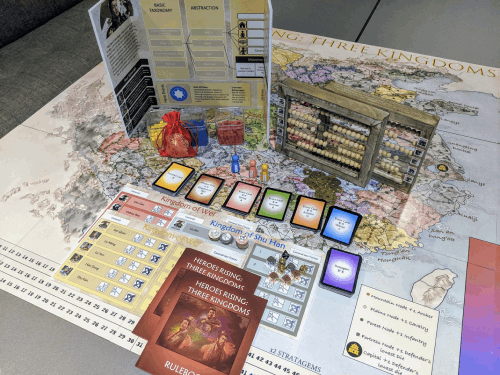
Heroes Rising: Three Kingdoms, an original educational wargame about the warring Three Kingdoms period in ancient China. The wargame was designed by students in the Basics of Wargaming course at Georgetown’s Security Studies Program.
Crawl, Walk, Run
Be patient and meticulously build your wargaming program, resisting the urge to run when you’re better off crawling. In the beginning, progress may be gradual, but these early steps will most likely become foundational cornerstones. This may sound simple, even obvious, but the temptation to skip basic steps is formidable – especially as organizational pressures and expectations rise. But like any budding insurgency, overextension can be a fatal enemy. In 2018, the Georgetown wargaming program was incredibly nascent, comprised of two Sunday seminar sessions per semester. Yet, these Sunday seminars served as critical incubators by fostering interest among the student body and piloting different approaches to teaching wargame design. Students from those early seminars would later comprise the first cohort of my Basics of Wargaming course at Georgetown and become student executives in the Georgetown University Wargaming Society (GUWS). Early experimentation and mistakes helped refine my course for its debut in 2019.
Many wargaming initiatives fail because they attempt to do too much, too quickly. The initial choice of wargames to play (or buy) is one example. For my courses, I predominantly utilize Game of Thrones Risk, Friedrich, and Axis & Allies as introductory games. The vast majority of my students, whether civilian or military, have little to no experience in hobby gaming or professional wargaming. The most common mistake is to force novice players to wrestle with an intimidating and complex game. Any existing ember of interest can be unceremoniously snuffed out. Therefore, the first games they’re introduced to must be simple, accessible, and dynamic. For instance, the rules for Friedrich, a game about the 7 Years War, is the size of a playing card. Nevertheless, whenever I run Friedrich, whether for colonels or civilian graduate students, the players learn about constraints of logistics, the importance of maneuver, and how to manage priorities against risks. Most importantly, the players want to play more and gain a taste for the power of game-based learning. It is an added bonus that the three aforementioned games contain a wide range of simple game mechanics, such as card-based adjudication, point to point movement, effect cards, and variable unit types. This allows students to begin assembling their mental repository of gaming mechanics. Later on, the students can advance to more complex, robust wargames, such as Empire of the Sun, A Distant Plain, Race to the Rhine, Twilight Struggle, and digital wargames like Command: PE. This steady, incremental process is similarly applicable in assisting educators unfamiliar with game-based learning in integrating wargames into their classroom. The key is to adopt an iterative approach, aiming to build on a litany of small successes.
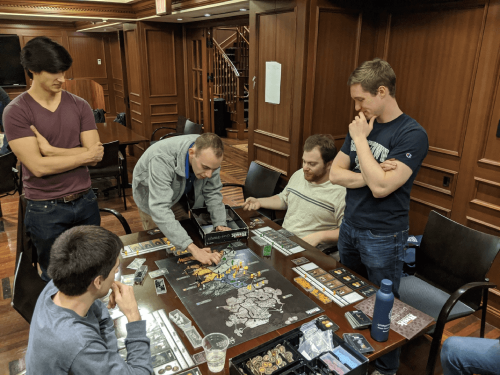
In January, Georgetown students played Game of Thrones Risk at a game night hosted by the Georgetown University Wargaming Society (GUWS).
Find Champions & Sponsors
Insurgencies without support are doomed to fail. This is as true in the halls of a university as it is in the mountains of Afghanistan. Support comes in two major forms, which I characterize as champions and sponsors. Champions are individuals or organizations that advocate for your cause both internally and externally, providing critical institutional cover and impetus for your insurgency to thrive. Sponsors provide material support or services, including games and funding.
At all three universities, the support of steadfast champions and sponsors proved absolutely critical in the inception of their respective wargaming programs. Rebecca Patterson, the Associate Director of SSP, not only offered the opportunity, but actively fostered the growth of my course at Georgetown. Similarly, Jonathan Phillips, Dean of Academics, COL Matthew Neumeyer, Deputy Director and Dean of Students, Michael Ronza, Deputy Director of Academic Operations, and, my co-instructors at CSC, Professors Craig Hayden and Paul Gelpi provided the impetus to create a wargaming design course within their Gray Scholars Program. Meanwhile, the Navy Marine Forces Center at RAND served as the critical sponsor, providing the funding and research support for the course. To establish the USNA Naval History Wargaming Lab (NHWL) and the corresponding wargaming design course, Claude Berube, director of the USNA Museum, and Marcus Jones, the inaugural NHWL director, continue to fulfill the roles of champions, sponsors, and collaborators.
The commercial gaming community has also proved indispensable in terms of sponsorship and support. In January, GUWS was only a few weeks old without a single game in its collection. By November, the GUWS gaming library featured over 130 unique game titles. This remarkable leap was made possible through donations from individual hobbyists, designers, and game publishers like PHALANX, GMT, MMP, Hollandspiele, the Dietz Foundation, Worthington Publishing, and numerous others. Consequently, the GUWS gaming library presently supports gaming sessions, enables game research for student game designers, and provides a game repository for partner educational institutions. The possibilities are no longer constrained by personal collections. The universe of games which students can explore is constantly expanding. The harsh reality is that funding and institutional arm-twisting turn the institutional gears, but with vocal champions and sponsors challenges can be overcome.
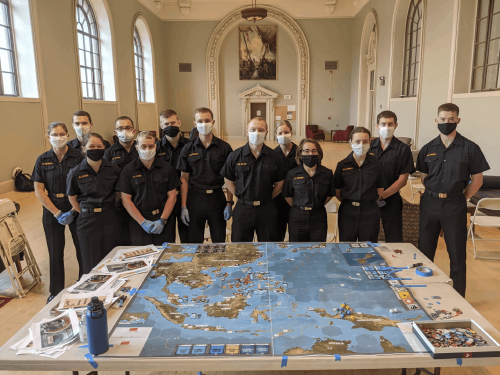
USNA midshipmen pose for a group photo after playing Assassin’s Mace, an educational wargame about modern conflict in the Indo-Pacific theater. Assassin’s Mace is designed by the U.S. Marine Corps Wargaming Division.
Collaborate to Generate Growth & Value
Your wargaming insurgency has steadily garnered experience, further armed with champions and sponsors in your corner – now what? How do you grow and avoid stagnation? A common solution is to collaborate with partners and aim to provide a service that generates value both within and beyond your home institution. This is mainly achieved in two ways: producing useful games and fostering long-term institutional relationships.
At all three universities, students research, design, develop, and execute educational wargames on a variety of military case studies. Aspiring wargame designers experience firsthand the challenges, the revelations, and the joy of the game design process. But just as importantly, the course produces a unique and recurring resource: a steady supply of educational wargames. At the USNA, the forthcoming NHWL wargame design course specifically selects military case studies to support existing courses of instruction. Consequently, educational wargames designed by midshipmen can be recycled back into other USNA courses as teaching tools – creating a virtuous cycle. Likewise, educational games designed by CSC students will eventually be shared with partnering Marine Expeditionary Units as training tools for Marines. In future iterations, we will be experimenting with partner instructors and organizations to serve as sponsors for the students’ games. This will allow the student design teams to craft games for a specific purpose and sponsor. The underlying principle is to create educational games with purpose, to provide value back to classrooms and partners.
Establishing a pipeline of educational wargames to partner organizations can serve as the basis for habitual, long-term relationships. In early 2020, my Georgetown students demonstrated their original educational wargames for the Brute Krulak Center for Innovation and Creativity. Hunched over their wargames, my Georgetown students interacted with their military peers over history, military strategy, and wargame design. But more importantly, this event cultivated a continuing and fruitful partnership with the Krulak Center – including GUWS’s participation in the 2020 Viking Shield Wargaming Tournament at Marine Corps University and annual wargame demonstrations from my course. The Simulation Education Division at Command and General Staff College, U.S. Army War College, and U.S. Naval College have also served as valuable partners. They have conducted wargames for my students, provided professional expertise, and volunteered as webinar speakers. Our partnerships are not limited to military Professional Military Education institutions, but include think tanks, commercial gaming forums, and international universities. The sheer range of partnerships has empowered students to showcase their wargames at conventions, garner interest in educational wargaming, and establish a network of collaborators. If there is a secret to building a successful wargaming insurgency, it may lie in finding like-minded collaborators and maintaining enduring partnerships.
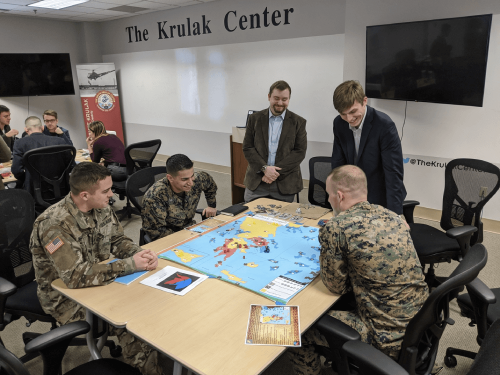
Georgetown graduate students run Hellenic Struggle, an original educational wargame on the Peloponnesian War, for Marine Corps University students at the Brute Krulak Center.
Be Adaptable and Exploit Opportunities
My favorite military maxim is: No plan survives first contact. Although trite and over-used, its relevancy is undeniable. At the beginning of the year, GUWS had grand ambitions and a packed agenda. We had facilities booked, speakers arranged, and games prepared. Then COVID struck with a fury, shutting down campuses and suddenly thrusting everyone into the virtual learning environment. None of our plans survived first contact with 2020. Consequently, we found ourselves in a precarious situation – adapt or become obsolete.
Pre-COVID, in-person game nights and demonstrations were our marquee program, the principle means of engaging with our membership and the wargaming community. Yet, with the ongoing ban on campus activities, we had to find new ways to remain relevant. In the early weeks of COVID, GUWS pivoted its once a month guest speaker series into a weekly webinar series. Originally a tangential effort, the series now features a diverse collection of wargaming topics, ranging from designing counterinsurgency wargames to Title 10 wargaming in the U.S. Air Force. Although challenging at first, the webinar series proved to be wildly successful, establishing GUWS as a known entity in the professional wargaming community. At the same time, game nights steadily shifted to digital platforms like Steam, Tabletop Simulator, Zoom, and Discord. The shift to the digital environment also opened new opportunities to leverage our partners. Unshackled from geographic co-location, professional defense wargamers from across the country could participate in student-led design presentations, which widened the pool of potential webinar speakers. Admittedly, the digital transition was not seamless nor effortless. Nevertheless, the ability to rapidly adapt and embrace new mediums allowed GUWS not only to survive the challenges of COVID, but to grow in unexpected ways.
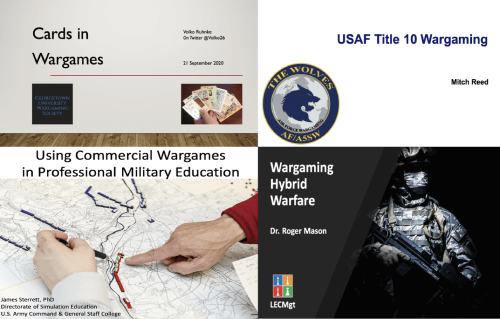
Cover slides from various GUWS webinar sessions covering a myriad of topics.
A Global Wargaming Insurgency
Wargaming is not a panacea for education and training; it is fraught with limitations. Nevertheless, when properly employed, wargaming can serve as a potent experiential learning tool. This has propelled an exciting wave of educational wargaming from the Australian Defense College to the U.S. Marine Corps. But islands of excellence are not enough. The plethora of educational wargaming initiatives cannot be trapped on individual islands – doomed to repeat the same mistakes and duplicate efforts. If educational wargaming is to evolve and endure, a global wargaming insurgency may be required. This will likely demand additional time, effort, and energy, but if successful, the dividends could be remarkable.
Sebastian J. Bae, a defense analyst at the nonprofit, nonpartisan RAND Corporation, works in wargaming, emerging technologies, the future of warfare, and strategy and doctrine for the U.S. Army and Marine Corps. He also serves as an adjunct assistant professor at the Center for Security Studies at Georgetown University, where he teaches a graduate course on designing educational wargames. He teaches similar courses at the U.S. Marine Corps Command and Staff College and U.S. Naval Academy. He is also the faculty advisor to the Georgetown University Wargaming Society, the Co-Chair of the Military Operations Research Society Wargaming Community of Practice, a Fellow at the Brute Krulak Center for Innovation and Creativity, and serves on the Executive Committee for the Educational Wargaming Cooperative. Previously, he served six years in the Marine Corps infantry, leaving as a sergeant. He deployed to Iraq in 2009.









Comments
Start the conversation by sharing your thoughts! Please login to comment. If you don't yet have an account registration is quick and easy.